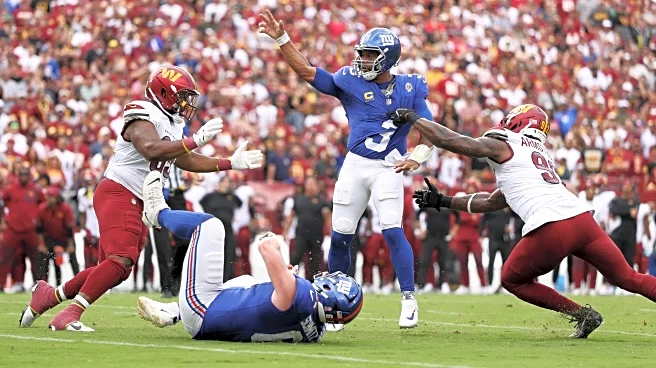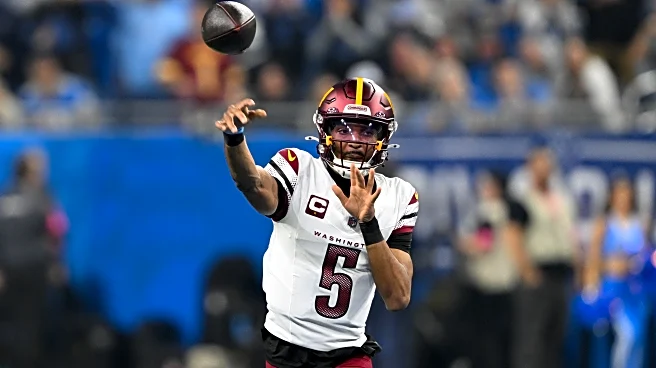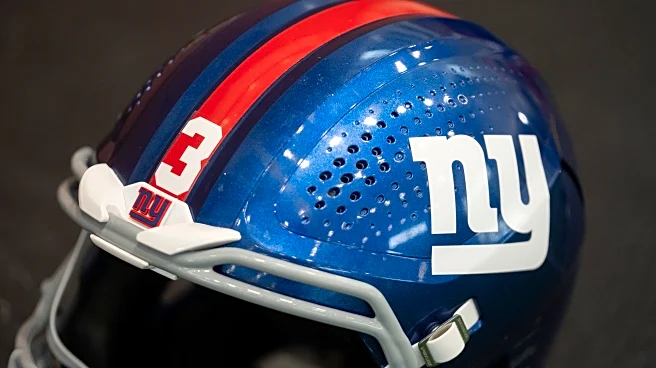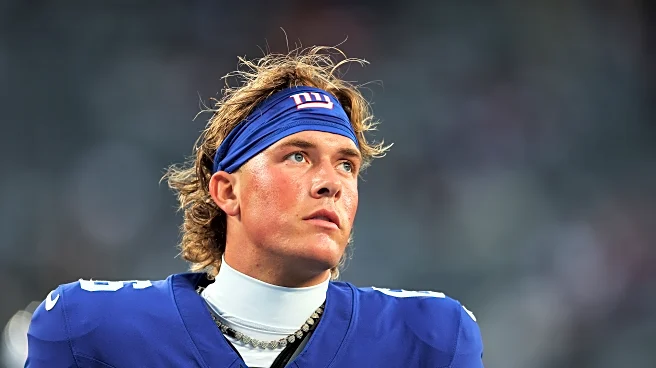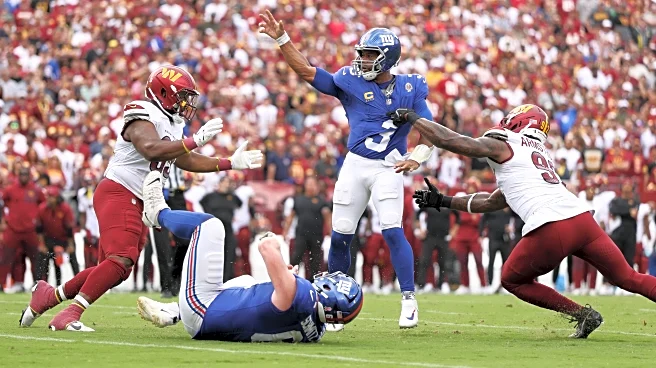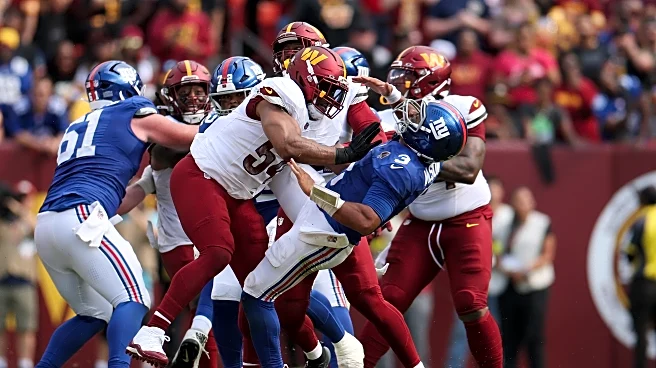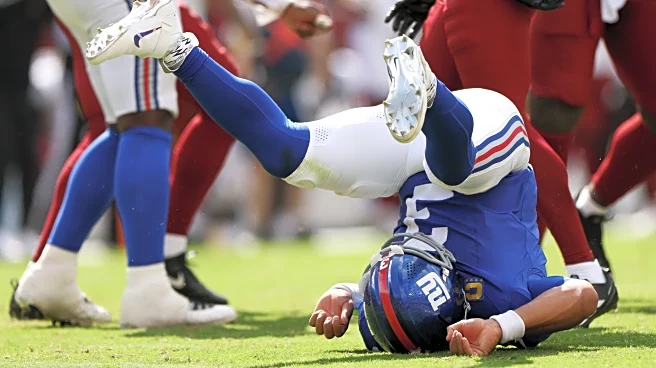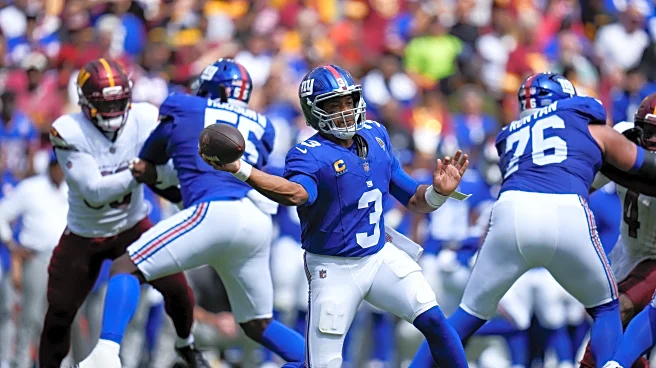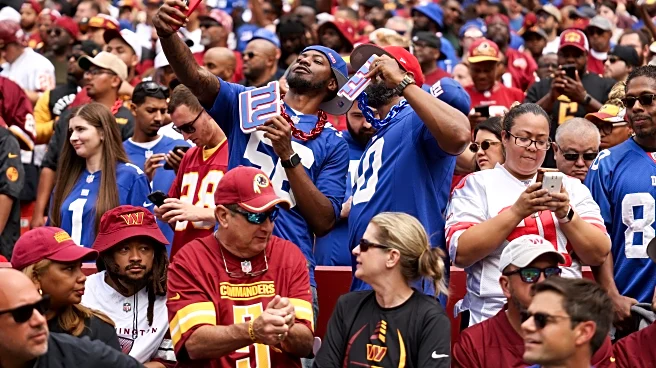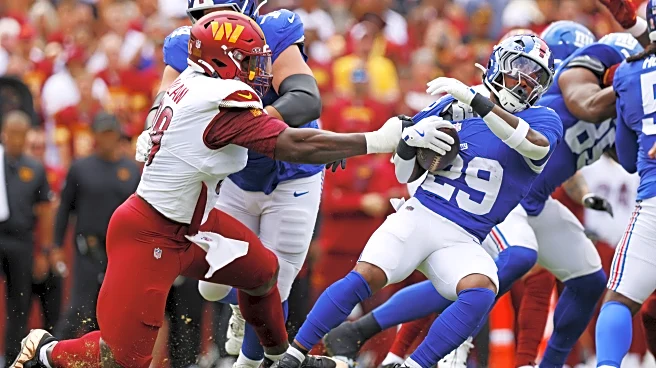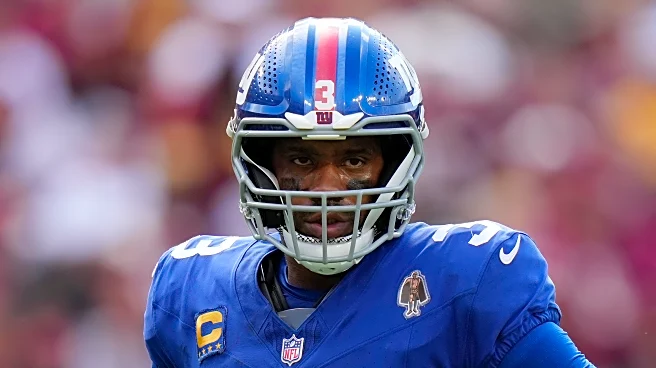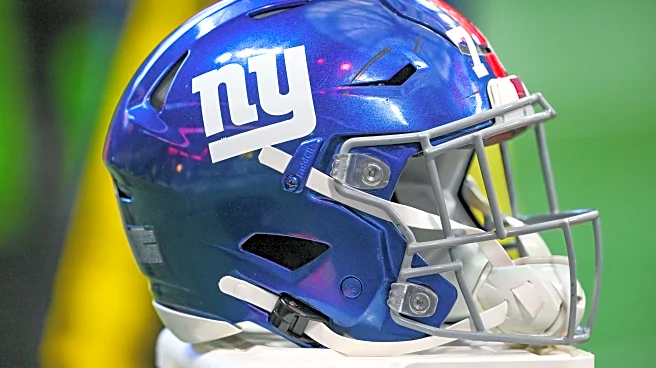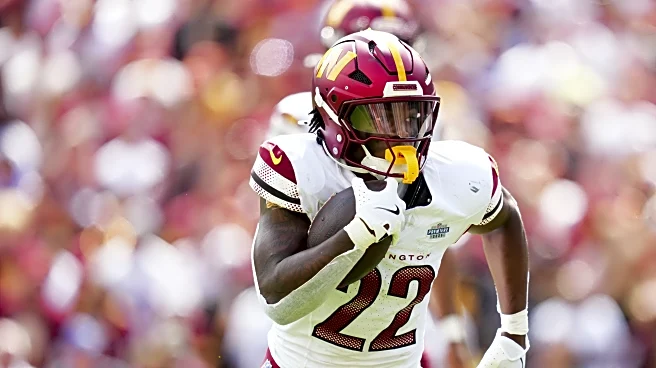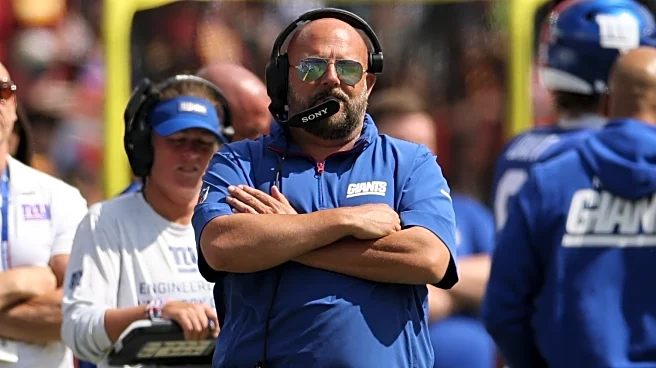
Another year, another Week 1 disaster for the New York Giants, this time a bad 21-6 loss to the Washington Commanders.
Things were supposed to be different this year. Brian Daboll got shouty in training camp and played the starters in the game — even after tough joint practices. The early results were fantastic, and the Giants finished the off-season as the eighth team to have a +60 point differential.
That obviously didn’t carry over into week 1. The defense, while they certainly had issue, did enough
to win. They held the Commanders to 14 points into the fourth quarter, and held runners not named “Jayden Daniels” to roughly 60 yards until a single 42-yard run on the final drive.
The offense, however, was atrocious.
They only had 231 total yards, 157 passing and 74 rushing (44 of which came from Russell Wilson), converted 4 of 16 third downs, and only scored 6 points despite having 13 plays inside the Washington 20-yard line.
So that all begs the questions: What the hell went wrong, and how can they fix it?
Skill position play
Going over the Giants’ offensive tape, there were certainly a bunch of problems, but I think they definitely boil down to two main ones. The play of the Giants’ skill position players wasn’t the main problem with the offense, but it did also contribute to everything feeling so disjointed and difficult.
That said, this is also a bit of an appetizer before the main course.
In the case of tight end Theo Johnson, he needs to be more consistent, and consistently physical, in his chip blocks as well as simply catching the ball. This play in the red zone is a good example.

The Giants’ slide protection leaves Dorrence Armstrong (92) essentially unblocked on the outside. Since the Giants are showing run-action to the offensive left, Johnson’s assignment should be the back-side block. He needs to be faithful to that assignment and disrupt Armstrong’s rush with a good chip. Instead he simply releases into his route without disrupting the defender at all.
Since this is a play-action pass, the chip block does multiple things within the structure of the play.
First, it helps to sell the run-action and keep the second level defenders faithful to their run fits. Second, it prevents the defender from getting into the passing lane and either influencing the throw or forcing the quarterback to speed up his process. Finally, it’s baked into the timing of the play, which we can see is off here. The ball has to come out before both Wilson and Johnson are ready. It probably wouldn’t have been a touchdown, but Johnson could have gotten to about the 5-yard line.
Running back Tyrone Tracy could also stand to be more assertive in how he approaches his pass protection duties. He is mostly used in scat protection (ie: releasing into routes as a check-down as opposed to directly blocking defenders), but there were instances in which he ran around defenders instead of giving them a proper chip. Perhaps the Giants will need to use their backs in protection more often and use fewer five-man protections.
The other side of the equation is that the Giants’ receiving options need to get open more quickly, and work to stay open. Take this first-and-10 play at the beginning of the fourth quarter.
At the moment of this first screen shot, Wilson is at the top of his drop and none of his receivers are open yet.

A couple seconds later, Wilson needs to flow within the pocket to buy time for his receivers to find the open field.

It appears as though Theo Johnson is breaking open over the middle, while Darius Slayton has grass in front of him down the sideline at the top of the screen. Unfortunately, both drift into coverage as Wilson tries to find them down the field. Slayton bends his route inward, toward the safety on his side of the field, while Johnson turns upfield and into the safety on his side of the field.

The Giants clearly want to generate an explosive play, but the deep options just aren’t open. Likewise, the underneath options aren’t available, which forces Wilson to heave the ball into the stands.
The offensive line
The Giants had issues all over their offensive line. James Hudson II struggled mightily — he’s a backup who played like a backup. Jon Runyan Jr., John Michael Schmitz, Greg Van Roten and Jermaine Eluemunor all also struggled. I do not want to minimize the issues there or the need for them to be addressed. I also don’t want this to seem like a hit piece on a veteran, singling him out as the problem with the offensive line.
That said, Hudson will go back to the bench. And (perhaps unfortunately) there isn’t much the Giants can do at the moment but trust and hope that Runyan and Schmitz will improve. Meanwhile, Van Roten had some very clear failures that resulted in plays being blown up before they had a chance to succeed, and the right guard position was also the only one to feature a camp battle with another player given reps with the starters.
The issues started on the Giants’ first offensive play, when a missed block resulted in a tackle for loss.

Van Roten completely misses his block on Javon Kinlaw as he slants inside from the B to A gaps. That miss also allowed an easy path for Bobby Wagner, who would have been much easier for John Michael Schmitz to pick up at the second level had Van Roten made the block.
This didn’t come out of nowhere, and there were evidence of struggles in the preseason.

That first missed tackle was probably Van Roten’s worst on the afternoon, but there were others where he either failed to use good technique or couldn’t lock in his blocks.

Rather than trying to fit a hand on DaRon Payne’s chest plat and lay a proper block, Van Roten drives his shoulder into the defensive tackle before releasing up to the second level to take on Bobby Wagner. While that wasn’t the sole reason why Eluemunor wasn’t able to block Payne, the lack of a proper double team allowed Payne to establish half-man leverage on Eluemunor and bull his way into the backfield. A regular hip-to-hip double team before releasing could have allowed Tracy the time to hit the hole and pick up positive yardage.

Here we see Schmitz and Van Roten failing to properly pass off and pick up a slanting lineman. It ultimately doesn’t matter because of the failure on the left side between Jon Runyan and James Hudson, however Van Roten fails to mirror Payne as he attacks the B-gap. Schmitz does a decent-enough job of engaging, but Van Roten doesn’t lock in his block and winds up lunging at the lineman. That prevents him from properly mirroring and Payne getting into the backfield. Had Hudson not failed, Payne was still half a step away and would have hit Wilson an instant later than he actually was.
Final thoughts: How can the Giants fix their offense?
The foundational question here is “Can the Giants fix things?” and I think the answer is “yes”, at least in part.
I don’t believe the Giants should give up on Theo Johnson or Tyrone Tracy, not by a long shot. However, I do believe their roles should be scaled back for the time being. In particular, I think I would elevate Daniel Bellinger from the third tight end (based on his snap count Sunday) to the primary tight end in 11-personnel packages. Bellinger might not have the same tantalizing athleticism as Johnson, but he’s more dependable as a blocker, route runner, and as a receiver.
Likewise, I would suggest a much more active running back rotation between Tracy, Devin Singletary, and Cam Skattebo.
Tracy’s elusiveness likely makes him the best option between the 20’s, and he’s a natural receiver. However, his pass protection and chip blocks still leave something to be desired. That shouldn’t be much of a surprise given that he only has two full years at the position. Singletary is a true veteran at the position, and Skattebo’s experience and intense physicality lend themselves to the aspects of a running back’s game beyond running the ball.
Taking things a step further, playing more 12, 13, 21, or even 20 and 02-personnel could improve matters. The Giants’ receivers outside of Malik Nabers aren’t so good that they’re objectively better options than their tight ends or running backs in the passing game. They used the 21-personnel “Pony Package” to good effect in 2022, and the duo of Tracy and Skattebo could present useful challenges to opposing defenses. Likewise, using Johnson and Bellinger together could help with blocking as well as give the Giants athletic catch-and-run options in the intermediate area of the field.
Likewise, Wilson’s timing and chemistry with the skill position players is something that should improve as he continues to work with his teammates. That said, the Giants need to do a better job of calling plays that provide quick answers to account for shoddy protection, as well as route combinations that scheme players open.
As for the offensive line? That one I’m considerably less sure about. There are four potential options open to the Giants, but none of them may be good.
The first is to trust that Van Roten is a veteran and a professional who will respond and raise his game.
Considering he was below average last year and had similar struggles in preseason, I don’t know if this is even a viable option. It is the one Brian Daboll has chosen for this week, however he might move off of it if we see a similar performance from the offensive line.
The next most likely option is to give Evan Neal a chance at the starting job. Neal split reps with Van Roten in camp and the preseason, but he was inactive in Week 1. It’s notable that Neal hadn’t played guard since 2019, and that was left guard, and he missed time during camp. If the coaching staff are even thinking of trying him as a starter, they might want him to get more practice time before seeing the field. That said, he didn’t play poorly in the preseason and his play strength, agility, and range as a puller could all be upgrades over Van Roten.
The Giants could also try Joshua Ezeudu at guard as well. Ezeudu has experience at both left and right guard, and did look good at guard in the preseason. They may prefer his versatility as a versatile depth piece, but he may also be their best option if they don’t believe Neal will ever be a viable option.
Finally, the Giants could try Marcus Mbow at right tackle and move Jermaine Eluemunor inside to guard. The team originally signed Eluemunor to play right guard and have insisted that Mbow is a tackle until proven otherwise. He had one play as a blocker against the Commanders, which resulted in him essentially tackling Skattebo. The team probably doesn’t want to throw him in the deep end, hence the jumbo tight end reps, and the team likely also doesn’t want to risk hurting weakening their edge blocking to reinforce the interior.
So can the Giants fix the problems with their offense that rendered them inept in Week 1?
That’s a definite “maybe”.
There are some aspects that they can fix, or take steps toward fixing. But when it comes to the offensive line, it really depends on whether they have the necessary pieces on hand. If none of their young depth players are capable of stepping up, then they’ll just have to make due.
